If you’re looking to add a touch of edginess and grit to your home decor, you might want to consider industrial interior design. Inspired by the raw and unfinished look of industrial spaces, this design style can transform any room into a cool and unique space that’s both functional and aesthetically pleasing.
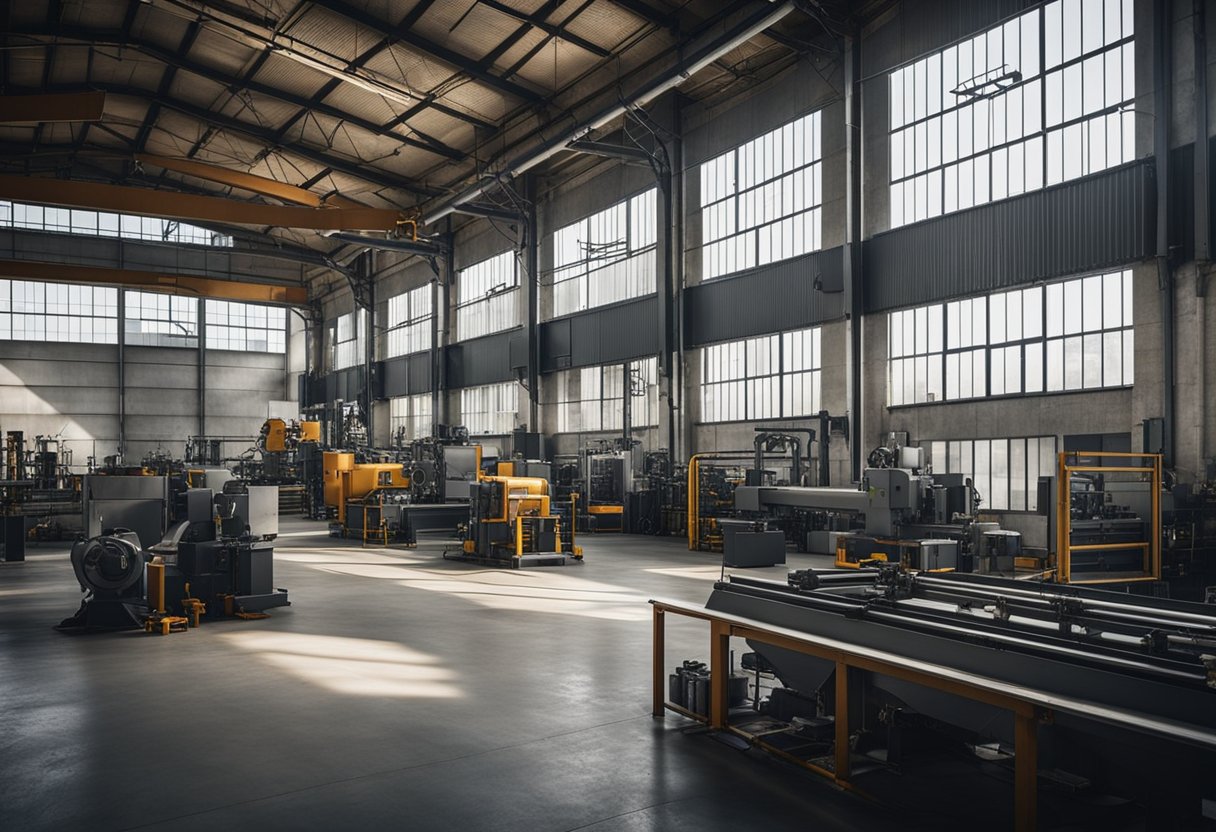
Industrial interior design finds its roots in the industrial revolution, which brought about new technologies and materials, as well as urbanization. This led to the creation of large, open spaces that were used for factories and warehouses. Industrial interior design takes inspiration from these spaces, using materials such as metal, wood, and exposed brick to create a rugged and utilitarian look.
To achieve an industrial interior design, you’ll need to focus on certain design principles and key elements. These include incorporating raw and unfinished materials, using a neutral colour palette, and adding vintage or repurposed furniture. By following these principles and incorporating industrial elements into your space, you can create a unique and stylish look that’s sure to impress.
Key Takeaways
- Industrial interior design takes inspiration from industrial spaces, using raw and unfinished materials to create a rugged and utilitarian look.
- Key design principles include incorporating raw materials, using a neutral colour palette, and adding vintage or repurposed furniture.
- By following these principles and incorporating industrial elements into your space, you can create a unique and stylish look that’s both functional and aesthetically pleasing.
History and Evolution
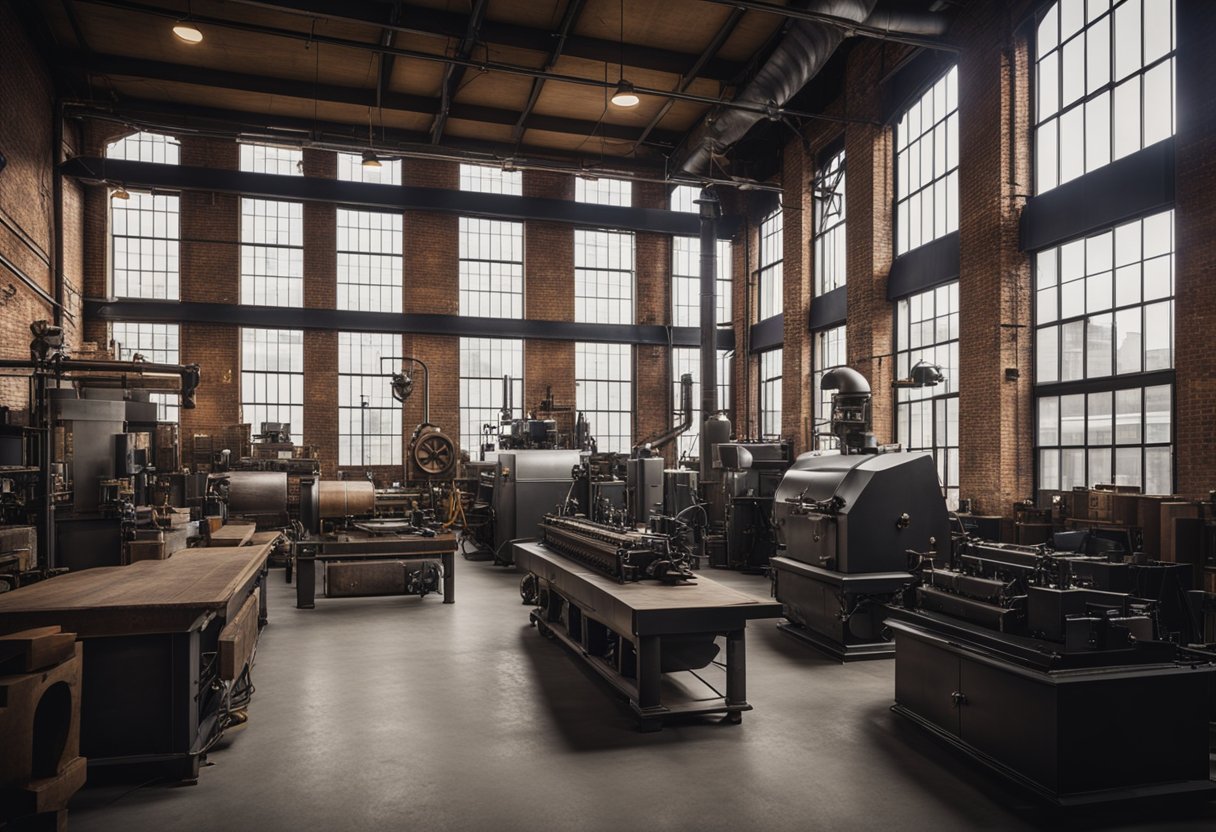
If you’re interested in interior design, you’ve probably heard about industrial design. It’s a style that has gained popularity in recent years, but did you know that it has roots that go back to the Industrial Revolution?
Industrial Revolution Origins
The Industrial Revolution was a time of great change in the world, and it had a profound impact on the way we live today. Factories and warehouses began to pop up everywhere, and people started to think differently about the way they designed their homes and workplaces.
The industrial interior design style takes inspiration from the factories and warehouses of the Industrial Revolution. It celebrates the raw beauty of industrialism, with exposed brick walls, metal pipes, and concrete floors.
Modern Industrial Design
Today, industrial interior design has evolved into a versatile and highly sought-after style. While it continues to celebrate the raw beauty of industrialism, it now embraces a wide range of influences, from modern minimalism to vintage chic, making it a timeless and adaptable design choice for a variety of spaces.
If you’re looking to incorporate industrial design into your home or workspace, there are a few key elements to keep in mind. Industrial design is all about simplicity, functionality, and practicality. Think exposed pipes, concrete floors, and metal accents.
Incorporating vintage elements, such as old factory lights or reclaimed wood, can add warmth and character to your space. And don’t be afraid to mix and match different textures and materials – industrial design is all about embracing the unexpected.
Overall, industrial interior design is a style that is both practical and beautiful. Whether you’re looking to create a sleek and modern office space or a cozy and inviting living room, industrial design is a versatile style that can work for any space.
Design Principles
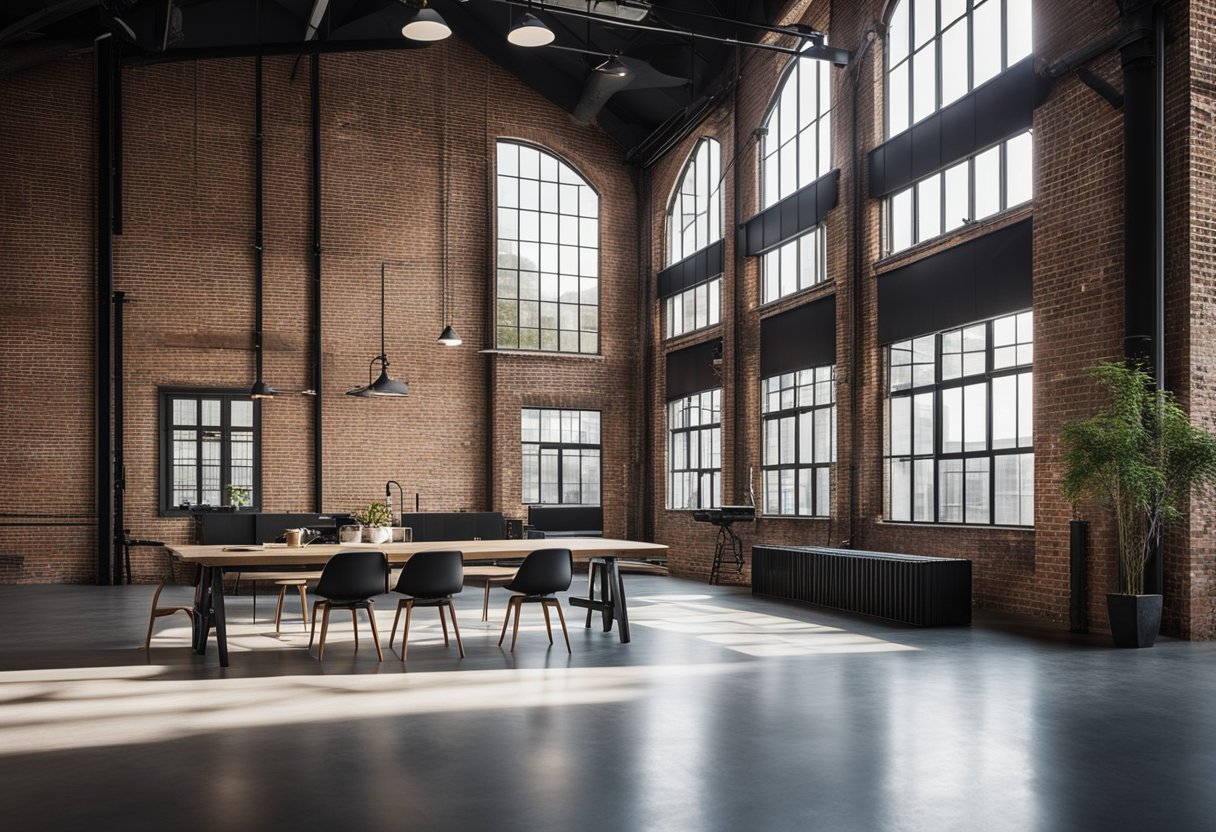
When it comes to industrial interior design, there are several key principles to keep in mind. By following these principles, you can create a space that is both functional and visually appealing.
Functionality and Minimalism
One of the hallmarks of industrial interior design is its focus on functionality and minimalism. This means that every element in the space should serve a purpose. Think clean lines, simple shapes, and a lack of unnecessary decoration. By keeping things simple, you can create a space that is both practical and aesthetically pleasing.
Open Space Concept
Another key principle of industrial interior design is the open space concept. This means that the space should be open and uncluttered, with plenty of room to move around. By creating an open space, you can make the most of the natural light and create a sense of flow throughout the room.
Contrast and Texture
To add interest to your industrial interior design, it’s important to incorporate contrast and texture. This means combining rough, textured materials like brick and concrete with smoother, more polished surfaces like metal and glass. By playing with texture and contrast, you can create a space that is visually dynamic and engaging.
In summary, industrial interior design is all about functionality, minimalism, and open space. By following these principles and incorporating contrast and texture, you can create a space that is both practical and visually appealing.
Key Elements of Industrial Style
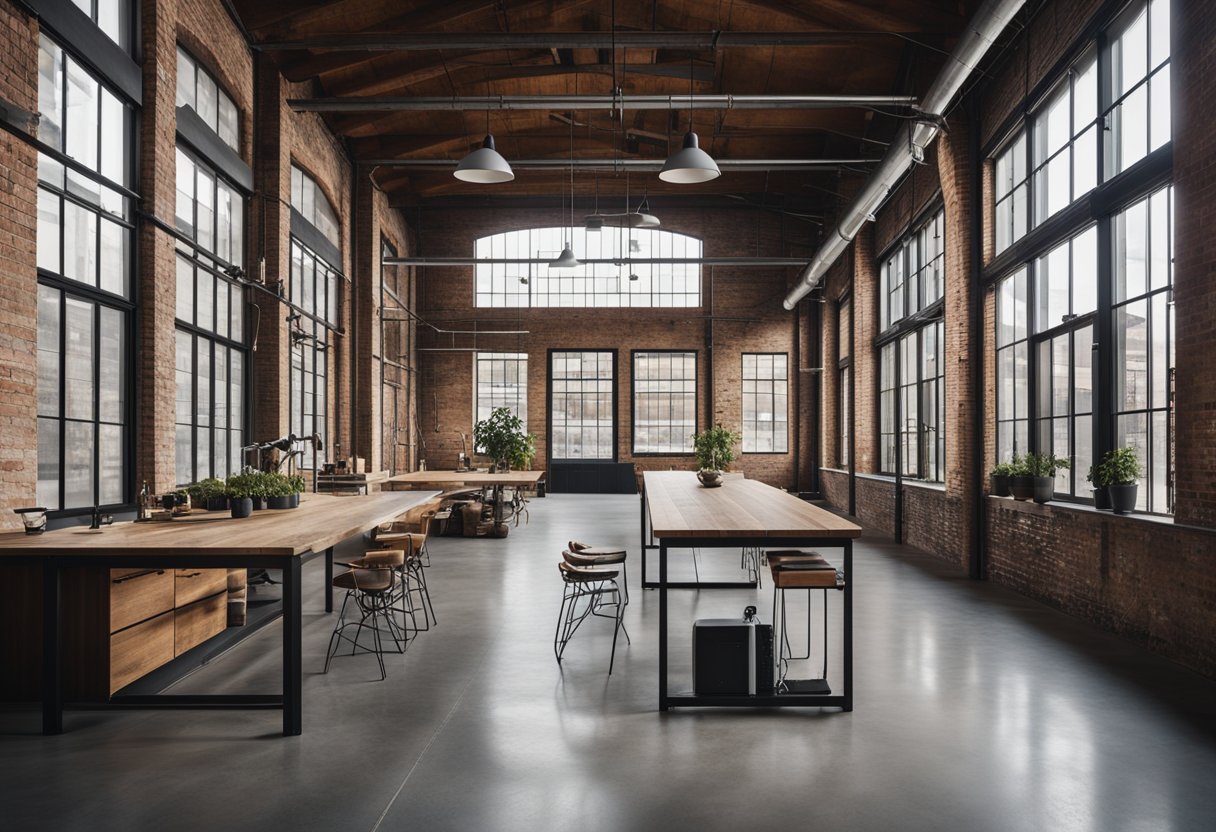
If you’re looking to create an industrial-style interior, there are several key elements you should consider. These elements include materials and surfaces, colour and lighting, and furniture and decor. By incorporating these elements into your design, you can achieve a cohesive and stylish industrial look.
Materials and Surfaces
One of the most important aspects of industrial design is the use of raw, unfinished materials. Materials like metal, concrete, brick, and wood are all commonly used in industrial interiors. Reclaimed wood is also a popular choice, as it adds a rustic, weathered look to the space. When it comes to surfaces, exposed pipes and ductwork can add an industrial edge, while large windows can bring in natural light and provide a connection to the outdoors.
Colour and Lighting
Industrial interiors often feature a cool, neutral colour palette. Shades of grey, black, and white are commonly used, along with pops of colour in the form of statement pieces or greenery. Lighting is also an important element of industrial design, with industrial-style pendant lights and other industrial lighting fixtures adding a touch of authenticity to the space. Natural light is also important, so consider incorporating large windows or skylights into your design.
Furniture and Decor
When it comes to furniture and decor, industrial interiors often feature pieces made from metal, steel, and leather. Industrial-style statement pieces like a large metal clock or an oversized factory-style pendant light can add a touch of drama to the space. Cozy elements like weathered wood and greenery can also help to soften the industrial look and make the space feel more inviting.
Incorporating these key elements into your industrial-style interior can help you achieve a cohesive and stylish look that is both functional and aesthetically pleasing.
Room-Specific Industrial Design
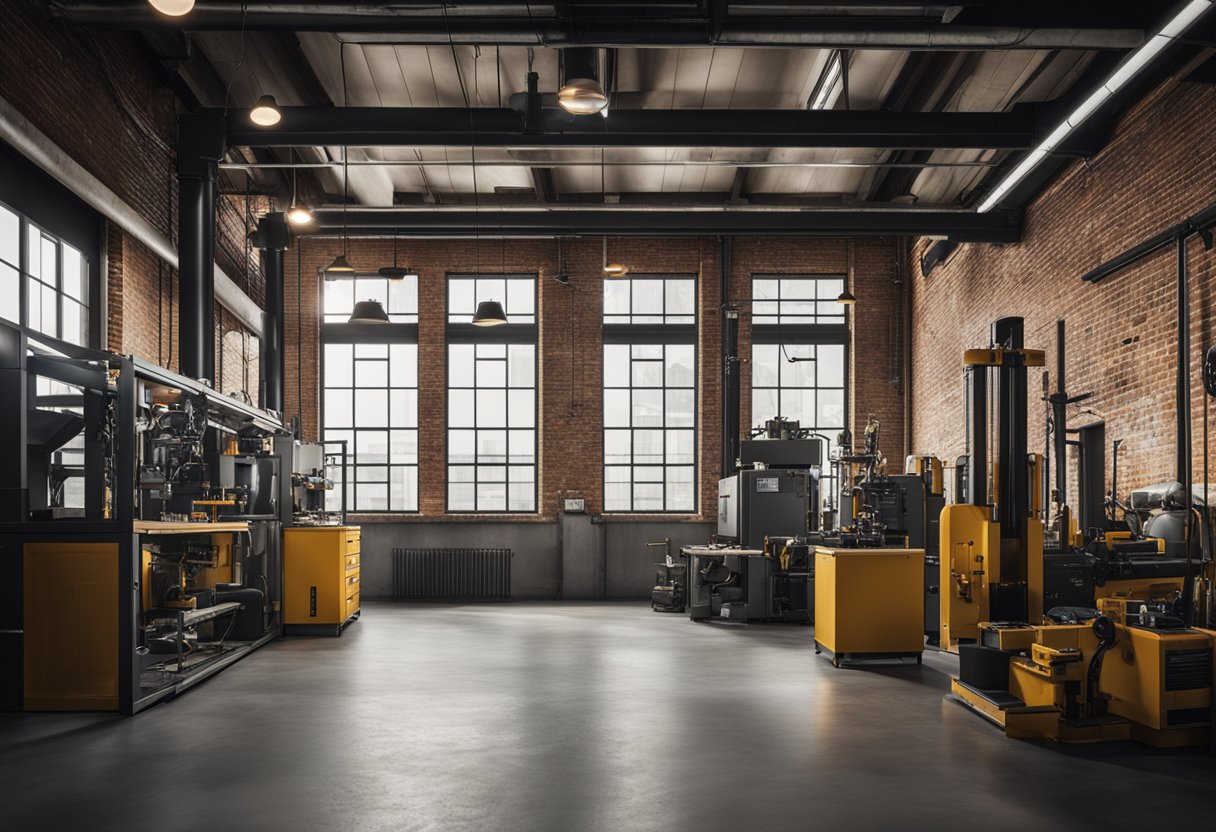
If you’re looking to incorporate industrial design into your home, it’s important to consider each room’s unique features and functions. Here are some tips for bringing industrial style into your kitchen, living room, bedroom, and bathroom.
The Industrial Kitchen
The kitchen is often considered the heart of the home, and industrial design can give it a unique and functional look. Consider using materials like stainless steel, concrete, and reclaimed wood to create an industrial feel. Bold lighting fixtures, exposed pipes, and open shelving can also add to the industrial aesthetic.
To create an industrial kitchen, consider using a large, stainless steel island as the centerpiece. You can also add industrial-style stools with metal frames and wooden seats. For storage, consider using open shelving made from reclaimed wood or metal pipes.
The Industrial Living Room
The living room is a space for relaxation and entertainment, and industrial design can add a touch of edgy sophistication. Consider using materials like leather, metal, and concrete to create an industrial feel. Exposed brick walls, concrete floors, and metal accents can also add to the industrial aesthetic.
To create an industrial living room, consider using a leather sofa with metal legs. You can also add industrial-style lighting fixtures, like a metal pendant light or an exposed bulb fixture. For a pop of colour, consider adding a vintage rug or a piece of art with bold colours.
The Industrial Bedroom
The bedroom is a space for rest and relaxation, and industrial design can create a calming and comfortable atmosphere. Consider using materials like wood, metal, and concrete to create an industrial feel. Neutral colours, like grey and beige, can also add to the industrial aesthetic.
To create an industrial bedroom, consider using a wooden bed frame with metal accents. You can also add industrial-style lighting fixtures, like a metal pendant light or a wall sconce. For storage, consider using a metal dresser or a wooden chest with metal handles.
The Industrial Bathroom
The bathroom is a space for hygiene and self-care, and industrial design can create a clean and modern look. Consider using materials like concrete, metal, and glass to create an industrial feel. Neutral colours, like white and black, can also add to the industrial aesthetic.
To create an industrial bathroom, consider using a concrete sink with metal accents. You can also add industrial-style lighting fixtures, like a metal pendant light or a wall sconce. For storage, consider using a metal shelving unit or a wooden cabinet with metal handles.
Incorporating industrial design into your home can be a fun and exciting project. By considering each room’s unique features and functions, you can create a cohesive and stylish look that is both functional and beautiful.
Incorporating Industrial Features
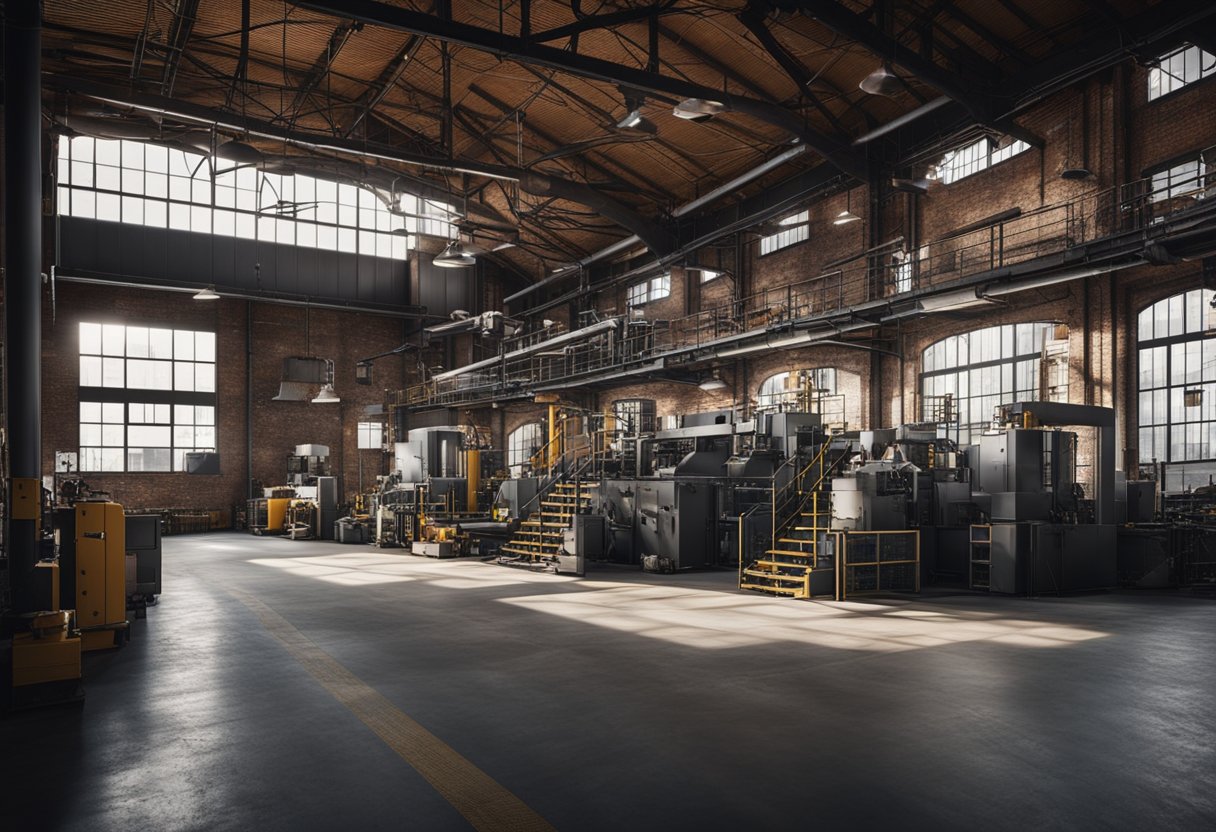
When it comes to industrial interior design, incorporating industrial features is a must. Whether it’s exposed structural elements or mixing textures and materials, these features add character and personality to your space. Here are some ways to incorporate industrial features into your home.
Exposed Structural Elements
Exposed structural elements such as beams, ducts, and pipes are key components of industrial design. Exposed brick walls and concrete floors are also great features to incorporate into your space. These elements add visual interest and texture to your home. You can also use these features to create a focal point in your room. For example, you can highlight an exposed brick wall by placing a vintage sofa against it.
Mixing Textures and Materials
One of the hallmarks of industrial interior design is the mix and match of textures and materials. Combining vintage pieces with modern industrial design is a great way to achieve this look. You can add metal accents to your space to create an industrial feel. For example, you can use metal chairs or a metal coffee table to add an industrial touch to your living room.
Vintage and Modern Fusion
Vintage and modern fusion is a popular trend in industrial interior design. This style combines vintage pieces with modern industrial design to create a unique and eclectic look. You can mix and match different textures and materials to create a cohesive look. For example, you can use a vintage leather sofa with a modern metal coffee table to create a stylish and comfortable living room.
Incorporating industrial features into your home is a great way to add character and personality to your space. Whether it’s exposed structural elements or mixing textures and materials, these features can help you achieve the industrial look you desire.
Accessorising Your Space
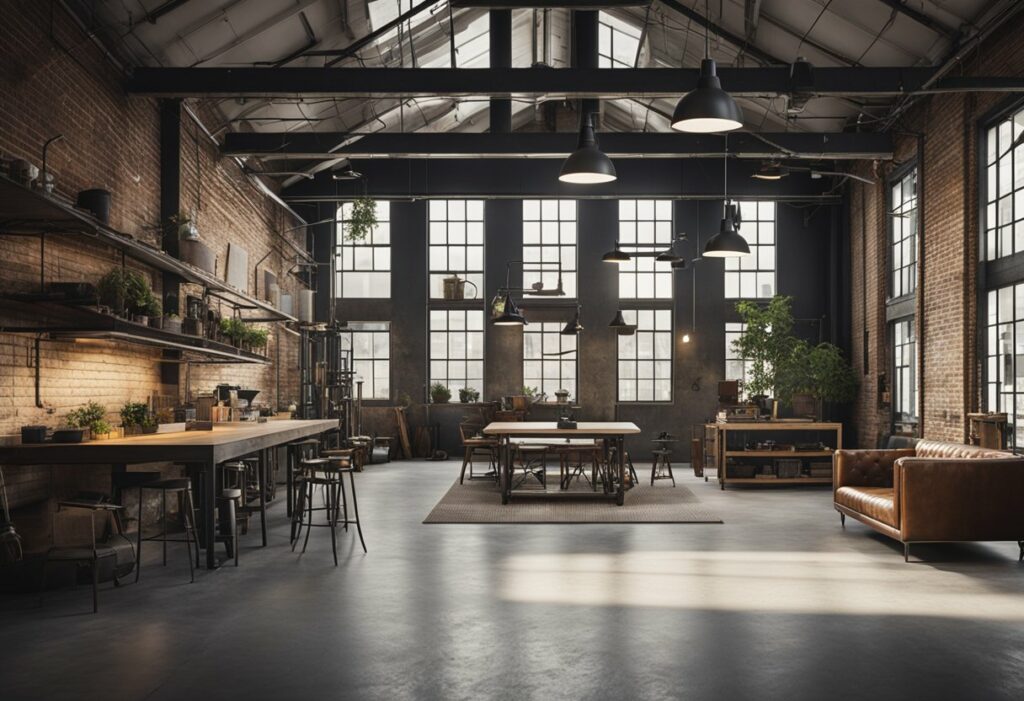
When it comes to accessorising your industrial interior, you want to strike the perfect balance between form and function. Whether you’re looking to add some extra warmth and texture to your space or simply want to enhance the overall aesthetic, there are a few key elements to consider.
Lighting Fixtures
Lighting is one of the most important aspects of any interior design scheme, and industrial interiors are no exception. When it comes to choosing lighting fixtures, you want to look for pieces that combine both form and function. Consider floor lamps, pendant lights or even exposed bulbs to add a touch of industrial style to your space.
Soft Furnishings and Accents
While industrial interiors are often associated with raw, unfinished materials, that doesn’t mean you can’t add some softness and warmth to your space. Linen and wool are great options for soft furnishings, while natural elements like wood and plants can help to bring a touch of the outdoors inside.
When it comes to accents, think about incorporating pieces that are both functional and stylish. Industrial-style shelving units, vintage clocks or even a statement piece of artwork can all help to add some personality and character to your space.
Remember, the key to accessorising your industrial interior is to strike the perfect balance between form and function. By choosing pieces that are both stylish and practical, you can create a space that is both beautiful and functional.
Challenges and Considerations
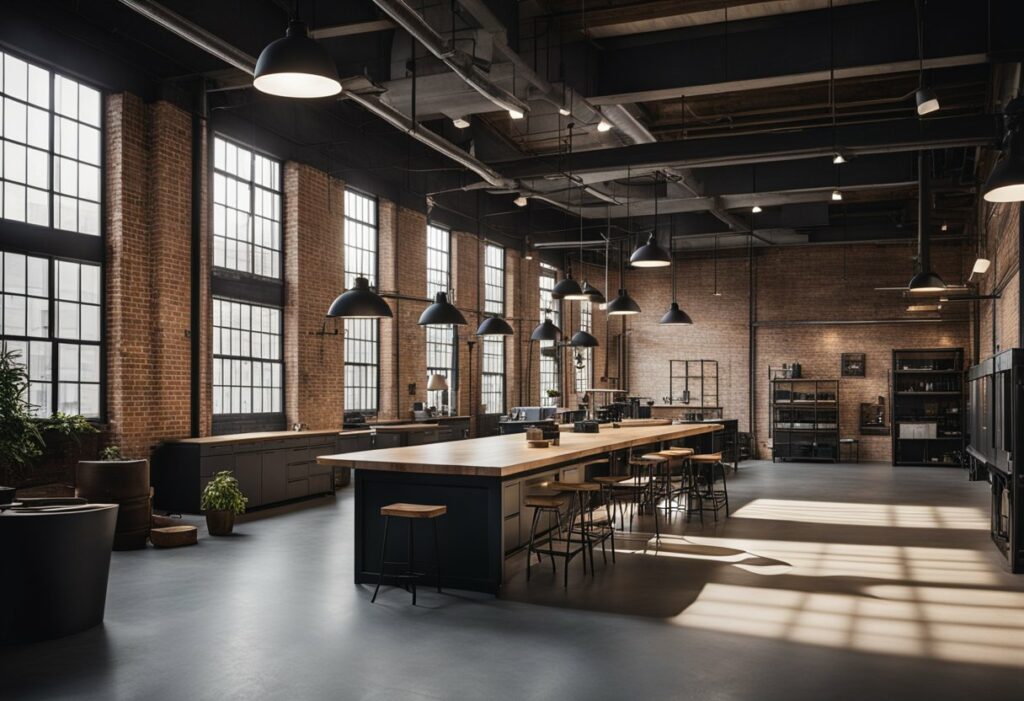
Maintaining Balance
When it comes to industrial interior design, maintaining balance is key. While the style is known for its raw and edgy aesthetic, it’s important not to go overboard and end up with a space that feels too cold or uninviting. One way to achieve balance is by incorporating elements of modern luxury into your design. Consider adding plush textiles, like velvet or faux fur, to soften the look of bare concrete walls and dark metal accents. High ceilings can also be balanced out with large-scale artwork or statement lighting fixtures.
Another approach to maintaining balance is by taking a minimalist approach to the design. Keep the space clutter-free and focus on a few key pieces that make a statement. This can be especially effective in a small condo or apartment, where too many industrial elements can make the space feel cramped.
Renovation and Adaptation
If you’re working on a renovation project, incorporating industrial elements into an existing space can be a challenge. One consideration is the use of distressed wood, which can add warmth and texture to the space. However, it’s important to ensure that the wood is in good condition and won’t pose any structural issues.
Bare concrete walls are another popular feature of industrial design, but they can be difficult to incorporate into an existing space. If your walls are already finished, you may need to consider adding a layer of plaster or concrete to achieve the desired look.
When adapting industrial design to a residential space, it’s important to consider how the space will be used. For example, a home office may require more natural light and a less austere aesthetic than a commercial space. With careful planning and attention to detail, you can create a space that balances the raw, edgy elements of industrial design with the comfort and functionality of a home.
Professional Insights

Tips from Designers
If you’re looking to incorporate industrial interior design into your home or office, there are a few tips from designers that can help you achieve the desired look. First, focus on incorporating industrial elements such as exposed pipes, brick walls, and metal accents. These elements are the hallmark of industrial design and can instantly transform any space.
Another tip is to mix and match different textures and materials. For example, you could pair a concrete floor with a wooden table or a leather sofa with a metal coffee table. This creates a visually interesting space that is both functional and stylish.
When it comes to lighting, industrial design often features large, statement pieces such as oversized pendant lights or vintage floor lamps. These pieces can add a touch of drama to any room and are a great way to showcase your personal style.
Sustainable Practices
As sustainability becomes an increasingly important issue, many designers are incorporating eco-friendly practices into their work. When it comes to industrial interior design, there are a few sustainable practices that you can adopt.
One option is to use reclaimed or recycled materials. For example, you could use old wooden pallets to create a coffee table or repurpose an antique metal sign as wall art. Not only does this help reduce waste, but it also adds a unique, vintage touch to your space.
Another option is to choose energy-efficient lighting options. LED bulbs are a great choice as they use less energy and last longer than traditional bulbs. You could also consider installing dimmer switches to help reduce energy consumption.
By following these tips from designers and incorporating sustainable practices, you can create an industrial chic space that is both stylish and environmentally friendly.
Cultural Impact and Trends
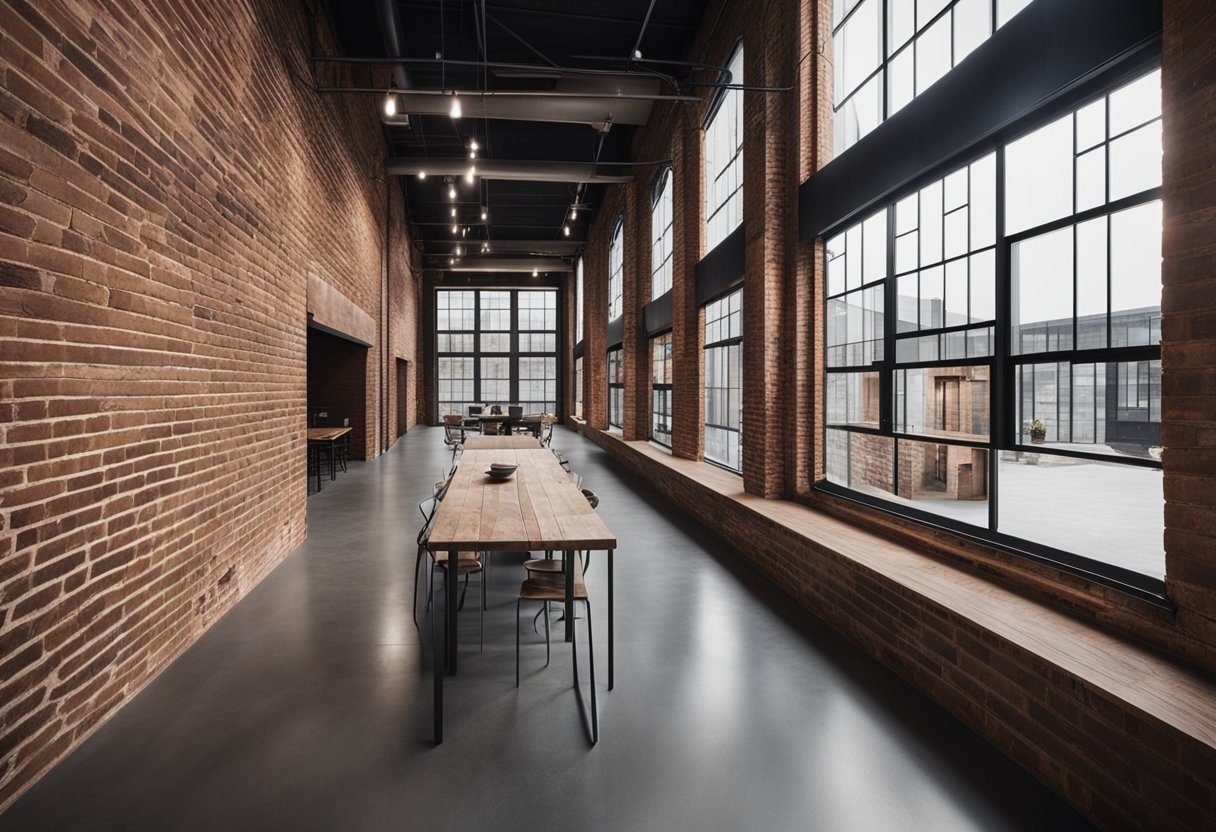
Industrial interior design has been influenced by various cultures and trends over the years. In this section, we will explore some of the global influences and future trends that have shaped industrial interior design.
Global Influence
Industrial interior design has been heavily influenced by the concept of “hygge” from Denmark. Hygge is a Danish word that translates to a feeling of coziness and contentment. This concept has been incorporated into industrial design by adding comfortable and warm elements to the typically cold and hard look of industrial materials.
Another global influence on industrial interior design is the use of stainless steel. This material is commonly used in industrial design due to its durability and sleek appearance. However, it has also been incorporated into modern design trends, where it is often paired with bold colours to create a striking contrast.
The Future of Industrial Design
The future of industrial interior design is exciting, with many new trends emerging. One trend is the use of home decor in industrial design. This involves incorporating elements such as plants and soft furnishings into industrial spaces to create a more inviting and comfortable atmosphere.
Another trend is the use of books in industrial design. Books can add a sense of warmth and personality to an industrial space, while also providing a source of inspiration for creativity.
Finally, colours are becoming increasingly important in industrial interior design. Bold and bright colours are being used to add personality and character to industrial spaces, while also creating a sense of fun and playfulness.
In conclusion, industrial interior design has been influenced by various cultures and trends over the years. As we move into the future, we can expect to see more exciting developments in this field, with a focus on creating warm and inviting spaces that are both functional and stylish.
Real-Life Examples
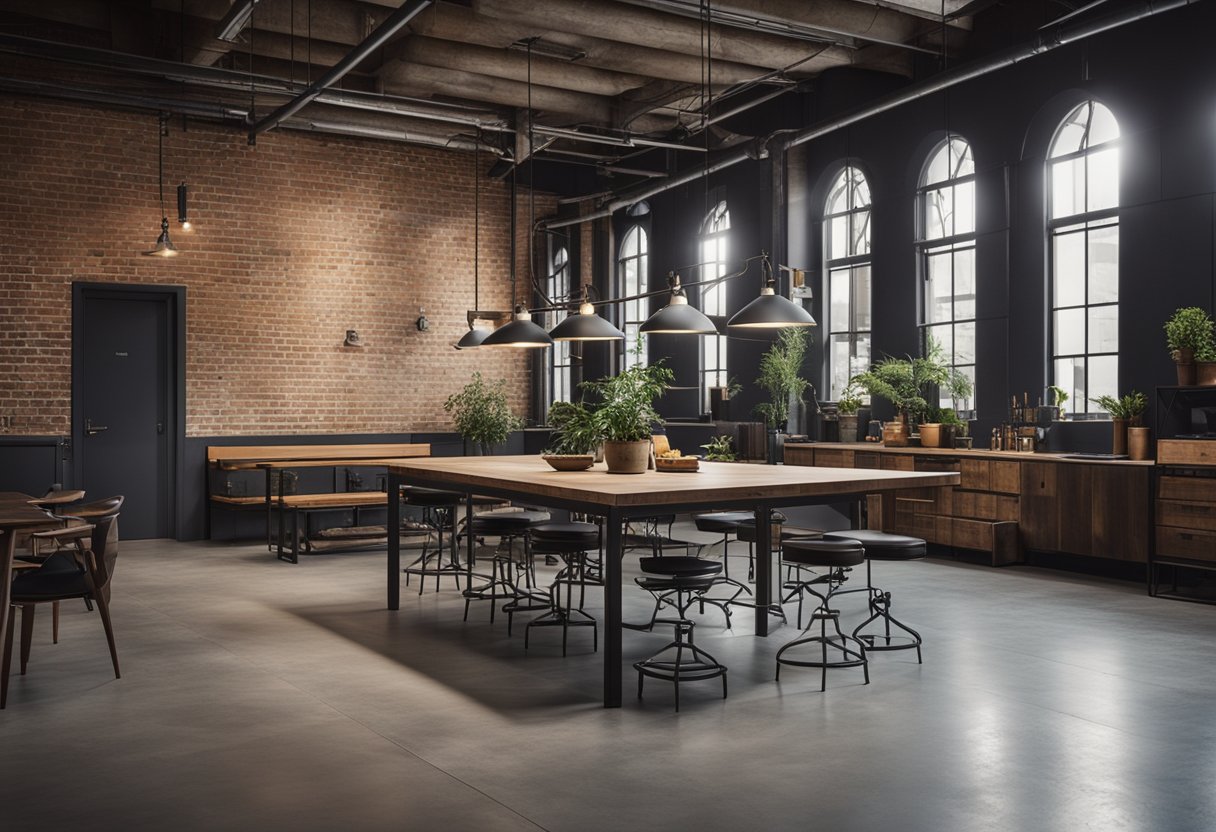
If you’re looking to incorporate industrial interior design into your space, it can be helpful to see real-life examples of how others have done it. Here are some examples of how people have used industrial design in their homes and commercial spaces.
Showcase Homes
HDB Flat
If you’re living in an HDB flat, you might think that industrial design won’t work in your space. However, with the right elements, you can create an industrial-inspired home that’s both stylish and functional. Consider incorporating exposed brick walls, metal accents, and Edison light bulbs for a vintage, industrial feel. To balance out the hard edges of industrial design, add some cozy elements like plush rugs and soft throw pillows.
Vintage Loft
If you’re lucky enough to live in a vintage loft, industrial design might come naturally to your space. Embrace the original brick walls, concrete floors, and exposed pipes, and add in some vintage furniture to complete the look. Consider hanging some industrial-style pendant lights over your dining table or kitchen island to add a modern touch.
Commercial Spaces
Cozy Cafe
Industrial design can work well in commercial spaces, too. If you’re opening a cafe, consider incorporating some industrial elements to create a cozy, inviting atmosphere. Use reclaimed wood for your tables and chairs, and add in some metal accents like shelving or light fixtures. To make your space feel even cozier, add in some plush couches or armchairs.
Open-Concept Office
If you’re designing an open-concept office, industrial design can help you create a functional, stylish space. Consider using a mix of materials like metal, wood, and concrete to create a modern, industrial look. Use open shelving to display books and files, and add in some comfortable seating areas for your employees to relax and collaborate.
Conclusion
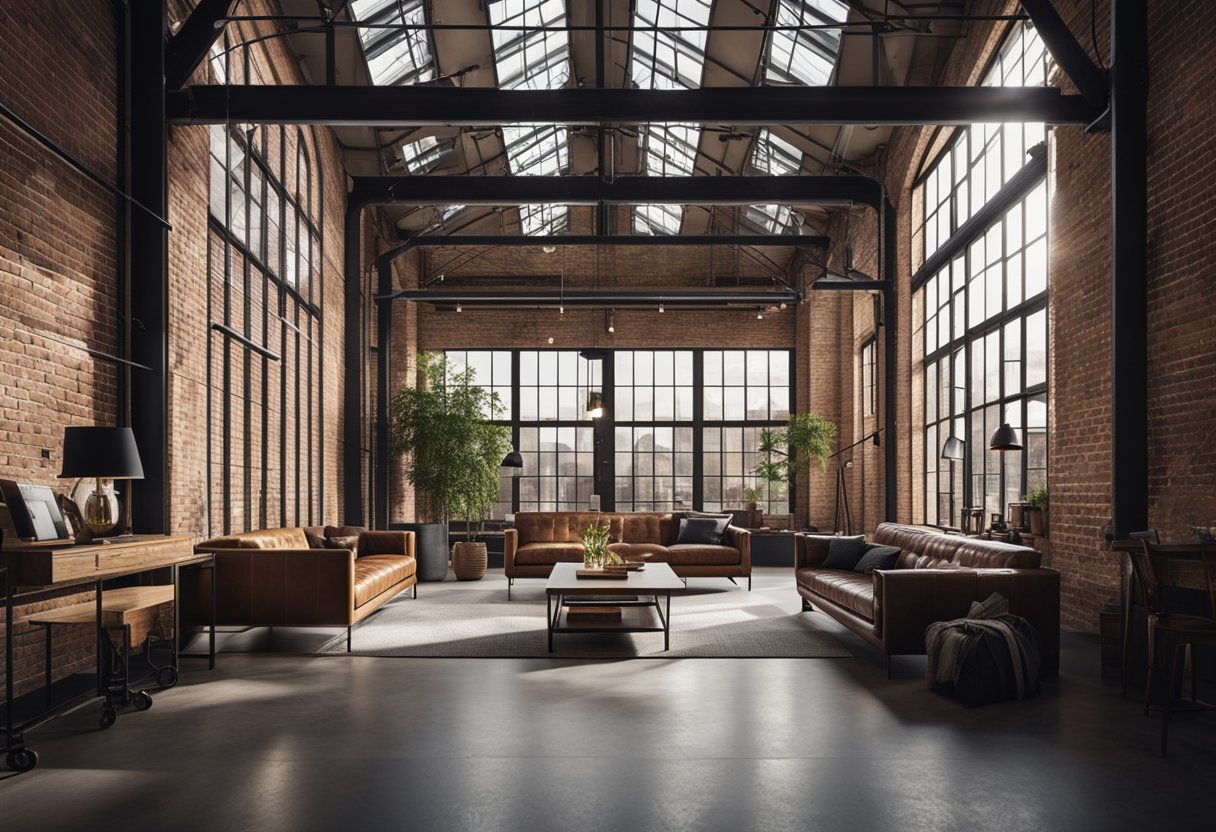
Congratulations! You now have a better understanding of industrial interior design. With its emphasis on raw materials, minimalist approach to furniture, and edgy, contemporary vibe, industrial design can breathe new life into any space.
Designers have embraced industrial interior design for its versatility and functionality. By incorporating materials such as metal, leather, brick, and wood, and embracing the structural elements of a space, designers can create an industrial aesthetic that is both practical and stylish.
When designing an industrial interior, functionality is key. Furniture and decor should be chosen with both form and function in mind. Industrial design is all about creating a space that is both beautiful and practical.
In conclusion, industrial interior design is a bold and unique style that offers a refreshing departure from the more traditional decor options. Whether you’re looking to create an industrial-inspired living room, bedroom, or office space, incorporating this style into your design scheme can help you achieve a look that is both stylish and functional.
Frequently Asked Questions
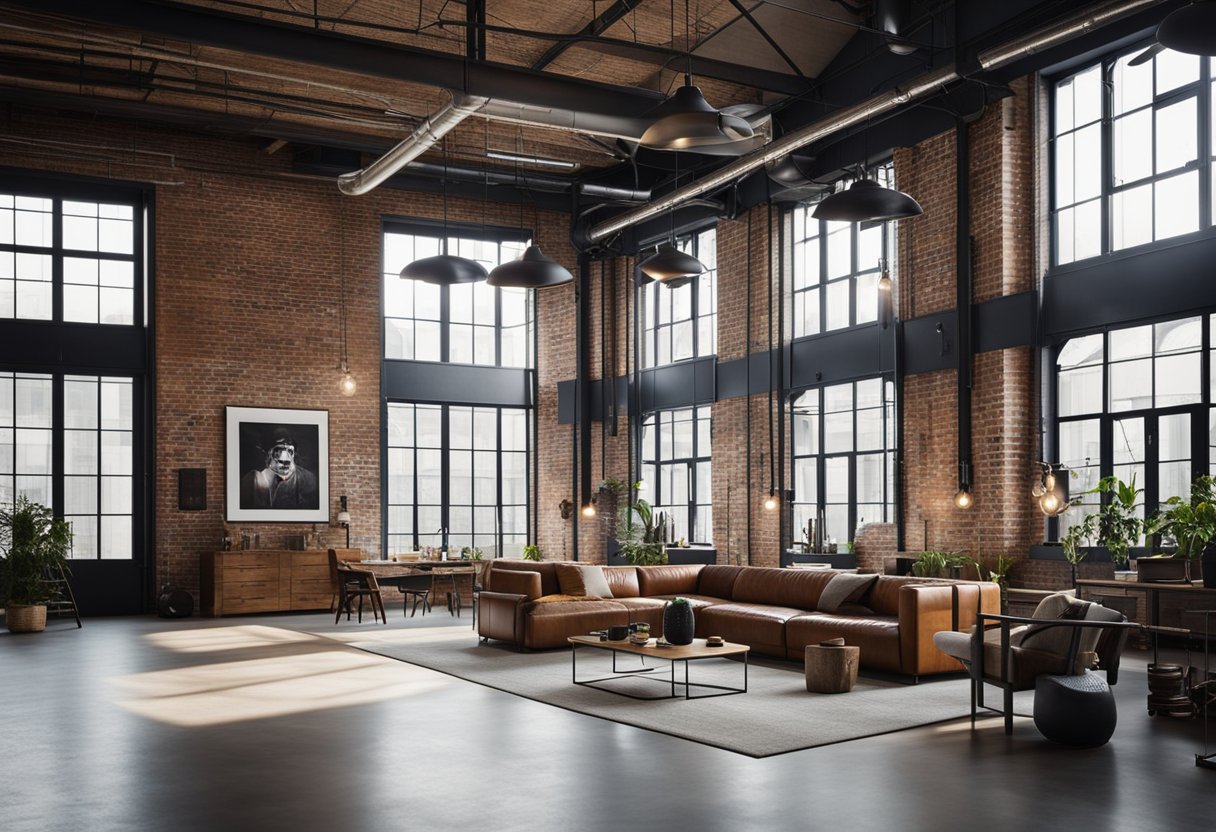
What are the defining features of industrial interior decor?
Industrial interior decor is characterized by a raw, edgy, and unfinished look that is often associated with factories and warehouses. The design style is driven by the use of raw materials such as brick, concrete, and metal, which are often left exposed to create a sense of authenticity and ruggedness. The style also features large windows, high ceilings, and open spaces that allow for plenty of natural light and airflow.
How do the materials in industrial styling contribute to its unique ambiance?
The materials used in industrial styling, such as metal, concrete, and brick, contribute to the unique ambiance of the style. These materials are often left unfinished, adding to the raw and edgy feel of the space. The use of these materials also creates a sense of authenticity and history, as they are often associated with factories and warehouses.
What are the latest trends in industrial-themed interior spaces?
The latest trends in industrial-themed interior spaces include the use of warm, natural materials such as wood and leather to soften the harshness of the industrial look. Another trend is the use of industrial lighting, such as exposed bulbs and wire cages, to create a sense of drama and contrast. The use of bold patterns and textures, such as chevron and herringbone, is also gaining popularity in industrial-themed spaces.
How can one incorporate industrial design elements into a residential flat?
To incorporate industrial design elements into a residential flat, you can start by using raw materials such as brick, concrete, and metal. You can also add industrial lighting, such as exposed bulbs and wire cages, to create a sense of drama and contrast. Another way to incorporate industrial design elements is to use industrial-inspired furniture, such as metal chairs and tables.
In what ways does industrial furniture enhance an interior’s aesthetic?
Industrial furniture enhances an interior’s aesthetic by adding a sense of authenticity and history to the space. The use of metal, wood, and leather in industrial furniture creates a rugged and edgy look that is both functional and stylish. Industrial furniture also provides a sense of contrast and drama when paired with softer materials such as textiles and upholstery.
Can you trace the evolution of industrial interior design through history?
Industrial interior design has its roots in the Industrial Revolution of the 19th century, which brought with it new technologies and materials. The style was first used in factories and warehouses, where the raw materials and open spaces were necessary for production. In the 20th century, the style began to be used in residential and commercial spaces, where it became associated with a sense of authenticity and ruggedness. Today, industrial interior design continues to evolve, with new materials and techniques being used to create a modern take on the classic style.


